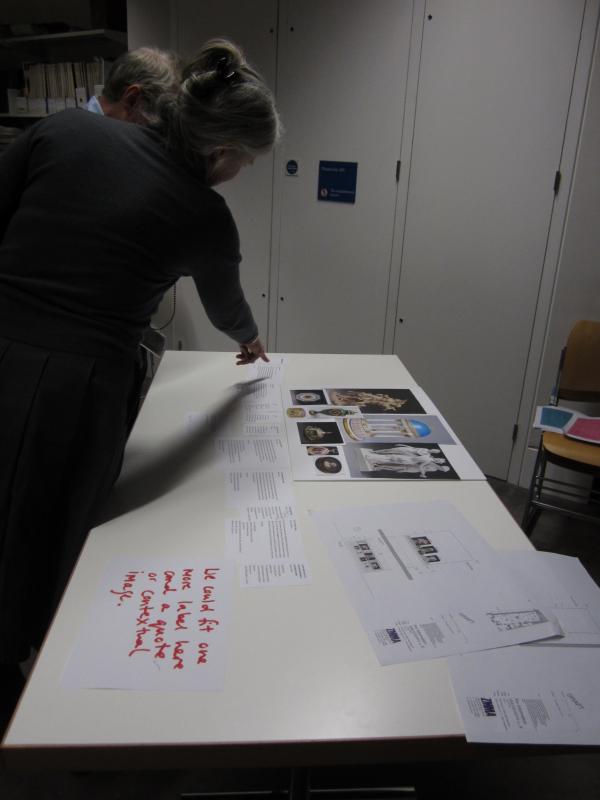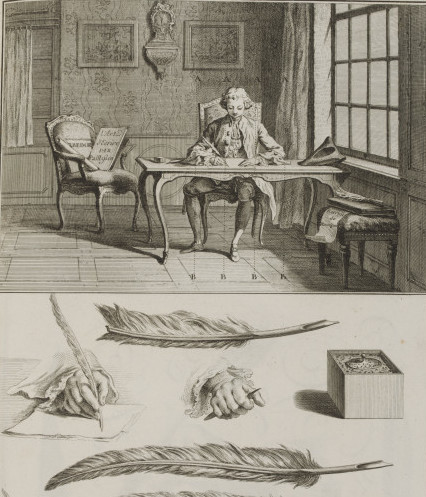With over a year until the Europe Galleries re-open, it may come as surprise to learn that we are already nearing the final stages of editing and confirming the text that will appear in the galleries. Indeed, we are doing so, even before the cases and walls, to which they will be fixed, exist!
In-situ-text is the term used to refer to all text that will be provided for visitors in the galleries – on walls, in cases and on plinths. It includes the text provided at the entrance to the suite of galleries and to each individual gallery, where we establish the overarching themes presented. It also embraces the text used to introduce each individual display and the labels accompanying each object.
The purpose of in-situ text is to help provide key information and help increase visitors’ understanding of the objects and subjects in museum displays.

![The purposes of these two objects may not be immediately obvious to visitors without some accompanying text. What do you think they were used for?? [Find out at the bottom of the page]](https://s3-eu-west-1.amazonaws.com/vam-blog/dp-content/46a33062b6025899b2cc93ab8630ba80.jpg)
There are numerous methods that that can be used to provide additional layers of interpretation in galleries. The Europe Galleries will also include films, audio-trails, activity areas and digital apps [more details of which will appear in future blog entries]. However, the fundamental form of interpretation that visitors expect to be present within galleries is in-situ text. Lucy Trench (Lead Educator for the Europe Galleries) describes succinct, focused in-situ text as ‘the bedrock of interpretation’.

There is currently a hive of activity as we finalise the label text for each object and display.
Writing gallery and label text is very different from writing books or scholarly articles. Distilling large amounts of detailed information or research about an object into a succinct, relevant, interesting and widely-accessible label can be a complicated, tricky and at times frustrating task. The use of labels in museums and galleries is a widely debated topic and there are numerous publications, articles and websites that propose and discuss the ‘best methods’ to use when writing labels.
The V&A has its own set of text guidelines, which you can read here [V&A Text Guidelines]. These show the V&A approach and all curators are expected to refer to it. Lucy Trench also runs training sessions for young curators, or those who need a refresher to prepare themselves for major projects. I won’t delve into the thorny topic of ‘label style’ debates here, but will instead provide a brief overview of the process we have used to produce the label text for the Europe Galleries.
Each object label will provide at a minimum what is known as ‘tomb-stone’ information – short factual information about the object and its creation. This includes categories such as:
- What it is
- Where, when and by whom it was made
- The materials and techniques used to make it
- Any inscriptions on it
- Its museum number
Some object labels will include further text providing more detailed information or descriptions. Additional text may be needed to explain exactly what a particularly unusual object is or how it was used. Alternatively extra information about one particular object may provide useful further context for the rest of the display. The space available in each display case determines the number of labels that can be included and how much description they receive.
Each Subject Parent (the person who has led the development of a display’s contents) meets with our Assistant Editor Susanna Haddon to discuss which objects would most benefit from additional text and how the space available for labels could be most effectively allocated.
- Each Subject Parent then writes up the first draft of label text for their display.NB: Although an individual creates the first draft, the writing of labels is very much a collaborative process. Labels will appear in the gallery without an author’s name, which helps remove any sense of an individual having sole ownership over their content.
- The curator overseeing the gallery that the display is in (the Gallery Parent) then collates, checks and edits the text for all of the displays in their gallery. This helps to ensure that there is consistency of style, tone and terminology.
- The labels are then circulated to the different collecting departments (e.g. Metalwork, Ceramics etc.) to ensure that all the information is correct, clear and reflects any recent discoveries they may have made when researching the objects.
- The labels are the submitted (with all comments, edits and suggestions) to the Europe Concept Team who sign-off of the label text and pass it on to the Assistant Editor working on the Europe Galleries.
- The Assistant Editor is then responsible for editing the final version of the text.
- The Lead Educator for the Europe Galleries then checks through the text before it is circulated it to all of the people mentioned above for final comments.
- The text is then submitted to the designer who will create the final label design.
This is a long and involved process but it helps ensure that any inaccuracies or confusing phrases are noticed and amended – and also that there is consistency through the suite of galleries. The production dates for some objects could be amended to be more precise following recent research discoveries. The label for this bird organ was also reworded to avoid references to ‘bird organs’ conjuring up the image of a bird’s innards!

It might sound slightly surreal but we have also undertaken mock-ups of the labels for some displays.

The display’s Subject Parent, the Europe Galleries Concept Team, Educators and Assistant Editor all attend so that any changes can be discussed there and then.


These sessions have proven to be really useful. They help us to avoid the glitches that can occur when objects, labels and design come together for the first time, during the installation of the galleries.
Laying out the label text in an approximation of the display arrangement allows us to experience and get a clearer idea of how it may be read and understood by visitors to the gallery. This helps us to assess how well the labels’ ordering of information works: for example, if any technical terminology is clearly explained before it is referred to in a later nearby label. It also allows us to consider if we have made best use of the label space and where contemporary quotes or imagery could be effectively included in the label strips.

We need to bear in mind constantly that it is impossible to predict from which direction visitors will approach a display and which labels they will choose to read or not read. We can’t assume that visitors will read all of the labels preceding a certain object so information needs to be clear without being repetitive.

I’m sure many of the curators would appreciate the sentiments of this label!
You can hear Lucy Trench speaking in more depth about the importance of gallery interpretation in relation to the Europe Galleries in this podcast http://www.vam.ac.uk/content/articles/v/v-and-a-podcast-europe-galleries/
—
The mystery objects were:





Who will create the final label design?
Good morning,
I’ve read this article before and noticed a few places which might need adjustments.
One bullet begins, “The labels are the submitted….” I suspect that ‘the’ should be ‘then.’ And, ‘of the label’ might be better as ‘on the label.’ Perhaps it’s just my way of speaking.
Another bullet reads, “The Lead Educator for the Europe Galleries then checks through the text before it is circulated it to all of the people mentioned above for final comments.” I’d suggest removing the second ‘it’ and ‘of.’
Finally, there is a paragraph which starts, “This is a long and involved process…and also that there is consistency through the suite of galleries.” I’m unsure “and also” reads easily.
Sincerely,
Craig
This is fascinating. One suggestion I would like to make is that – where possible – display cases also have a card for ‘bibliography’ or further references if a visitor would like to investigate further or find out more. Could be done with a QR code.